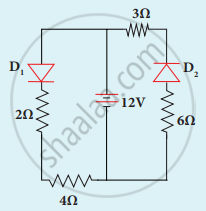Advertisements
Advertisements
Question
Explain the working principle of a solar cell. Mention its applications.
Solution

Cross-sectional view of a solar cell
1. Solar cell converts light energy directly into electricity or electric potential difference by the photovoltaic effect.
2. It generates emf when radiations fall on the p-n junction. A solar cell is of two types p-type and n-type.
3. Both types use a combination of p-type and n-type silicon which together forms the p-n junction.
4. In solar cells, electron-hole pairs are generated due to the absorption of light near the junction.
5. Electrons move towards n-type silicon, holes move towards the p-type silicon layer.
6. Electrons reaching the n-side are collected by front contact and holes reaching p-side are collected by back electrical contact.
7. Thus potential difference is developed across solar cells. When an external load is connected, photocurrent flows through it.
8. Many solar cells are connected in series or parallel to form solar panels or modules.
Applications:
- Widely used in calculators, watches, toys, portable power supplies, etc.
- Used in satellites and space stations.
- Solar panels are used to generate electricity.
APPEARS IN
RELATED QUESTIONS
If a positive half-wave rectified voltage is fed to a load resistor, for which part of a cycle there will be current flow through the load?
The barrier potential of a p-n junction depends on
(i) type of semiconductor material
(ii) amount of doping
(iii) temperature
Which one of the following is correct?
What do you mean by leakage current in a diode?
List the applications of light emitting diode.
Give the principle of solar cells.
Draw the circuit diagram of a half wave rectifier and explain its working.
Explain the construction and working of a full-wave rectifier.
Write notes on the photodiode.
Explain the formation of depletion region and barrier potential in PN junction diode.
Determine the current flowing through 3 Ω and 4 Ω resistors of the circuit given below. Assume that diodes D1 and D2 are ideal diodes.

